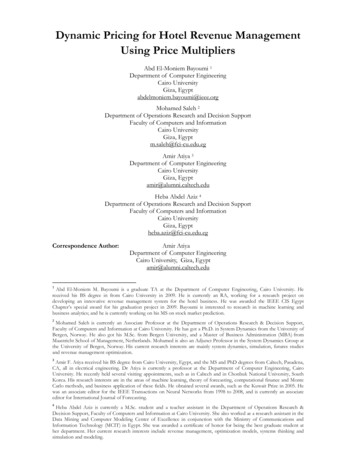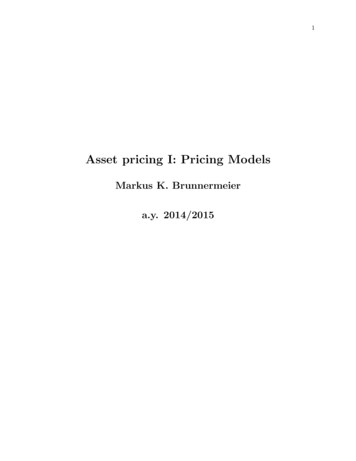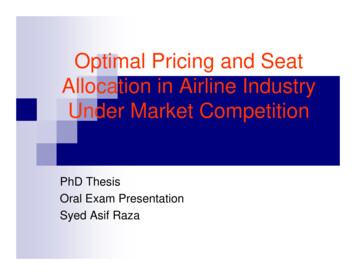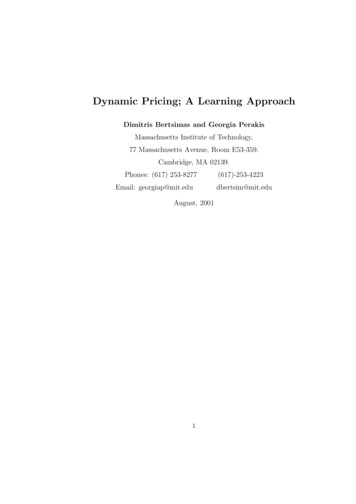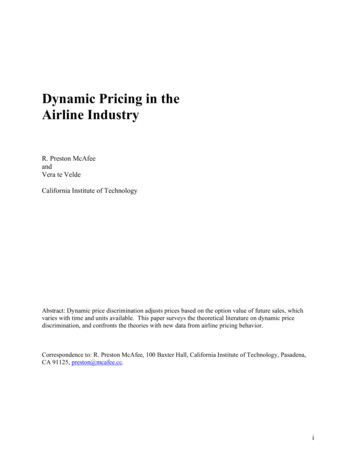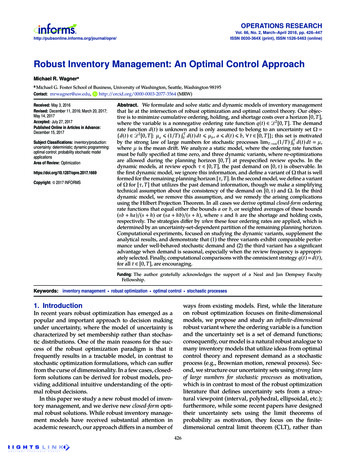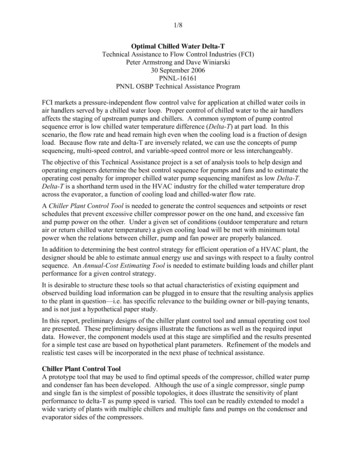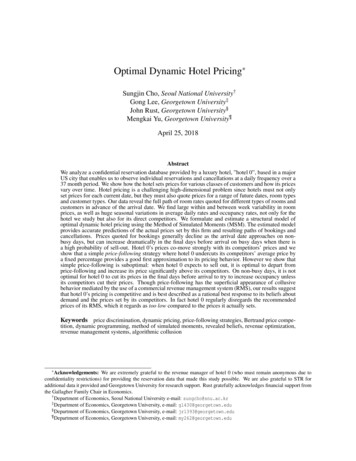
Transcription
Optimal Dynamic Hotel Pricing Sungjin Cho, Seoul National University†Gong Lee, Georgetown University‡John Rust, Georgetown University§Mengkai Yu, Georgetown University¶April 25, 2018AbstractWe analyze a confidential reservation database provided by a luxury hotel, ”hotel 0”, based in a majorUS city that enables us to observe individual reservations and cancellations at a daily frequency over a37 month period. We show how the hotel sets prices for various classes of customers and how its pricesvary over time. Hotel pricing is a challenging high-dimensional problem since hotels must not onlyset prices for each current date, but they must also quote prices for a range of future dates, room typesand customer types. Our data reveal the full path of room rates quoted for different types of rooms andcustomers in advance of the arrival date. We find large within and between week variability in roomprices, as well as huge seasonal variations in average daily rates and occupancy rates, not only for thehotel we study but also for its direct competitors. We formulate and estimate a structural model ofoptimal dynamic hotel pricing using the Method of Simulated Moments (MSM). The estimated modelprovides accurate predictions of the actual prices set by this firm and resulting paths of bookings andcancellations. Prices quoted for bookings generally decline as the arrival date approaches on nonbusy days, but can increase dramatically in the final days before arrival on busy days when there isa high probability of sell-out. Hotel 0’s prices co-move strongly with its competitors’ prices and weshow that a simple price-following strategy where hotel 0 undercuts its competitors’ average price bya fixed percentage provides a good first approximation to its pricing behavior. However we show thatsimple price-following is suboptimal: when hotel 0 expects to sell out, it is optimal to depart fromprice-following and increase its price significantly above its competitors. On non-busy days, it is notoptimal for hotel 0 to cut its prices in the final days before arrival to try to increase occupancy unlessits competitors cut their prices. Though price-following has the superficial appearance of collusivebehavior mediated by the use of a commercial revenue management system (RMS), our results suggestthat hotel 0’s pricing is competitive and is best described as a rational best response to its beliefs aboutdemand and the prices set by its competitors. In fact hotel 0 regularly disregards the recommendedprices of its RMS, which it regards as too low compared to the prices it actually sets.Keywords price discrimination, dynamic pricing, price-following strategies, Bertrand price competition, dynamic programming, method of simulated moments, revealed beliefs, revenue optimization,revenue management systems, algorithmic collusion Acknowledgements:We are extremely grateful to the revenue manager of hotel 0 (who must remain anonymous due toconfidentiality restrictions) for providing the reservation data that made this study possible. We are also grateful to STR foradditional data it provided and Georgetown University for research support. Rust gratefully acknowledges financial support fromthe Gallagher Family Chair in Economics.† Department of Economics, Seoul National University e-mail: sungcho@snu.ac.kr‡ Department of Economics, Georgetown University, e-mail: gl430@georgetown.edu§ Department of Economics, Georgetown University, e-mail: jr1393@georgetown.edu¶ Department of Economics, Georgetown University, e-mail: my262@georgetown.edu
1IntroductionWe analyze a unique new micro panel dataset of daily observations of reservations, prices, and occupancyof a luxury hotel based in a major US city. Due to the confidential nature of the data we are unable to revealthe name of the hotel or the city where it is located. Hereafter we refer to it as “hotel 0” since it is one of 7competing luxury hotels (with its competitors labeled 1 to 6) that constitute a local market in a small buthighly desirable location of this city. We formulate and estimate a dynamic model of optimal pricing byhotel 0: it sets its prices to maximize its expected profits (revenue less cost of cleaning/servicing rooms)as a best response to its beliefs about the arrival of customers and the dynamics of its competitors’ prices.Our main finding is that our model provides surprisingly accurate predictions of the prices set by hotel 0.This suggests that hotel 0 is setting prices in an approximately optimal fashion and is consistent with thehypothesis that there is a dynamic Bertrand price equilibrium in this particular luxury hotel market.Hotel pricing is a challenging problem since beside setting different prices for various room categories(standard rooms, deluxe rooms, penthouse suites, etc) and customer categories (tourist versus businessguests, group discounts for corporations, governments, etc.) a hotel manager must be able to continuouslyupdate and quote a large array of future prices since most of its customers book rooms well in advance oftheir planned arrival date. Optimal pricing depends critically on accurate knowledge of customer demand,and there are two key aspects to this: 1) recognizing the stochastic nature of demand and bookings andbeing able to use pricing to accommodate large day-to-day swings in the number of customers wishing tostay in one of the hotels in this market, and 2) understanding customers’ evaluation of the relative desirability of the competing hotels and their degree of price sensitivity, and being able to exploit differencesalong these dimensions among its various types of customers.We introduce a dynamic model of hotel demand that captures these two key aspects of demand. Customers arrive stochastically and reserve a room at hotel 0 or one of its competitors at randomly distributedlead times prior to arrival. Our model allows for stochastic cancellations but not overbooking: the dynamic allocation of capacity subject to “hard” capacity constraints is central to our explanation of hotel0’s price setting behavior. Though we have daily observations of the best available rate (BAR) of comparable rooms quoted by the six competing hotels, we only observe the number of new reservations (andcancellations) at hotel 0, but not at its competitors. Thus, we face a problem of censoring that makes itchallenging to estimate customer demand, and without knowing demand, it is hard to set good prices.Via a matched dataset provided by STR, we observe the total occupancy and average daily rate (ADR)for all seven hotels on a daily basis. The ADR is an average of different prices paid by different customerswho reserved at different times and may have been eligible for various group or corporate/government1
discounts. If we use ADR in place of the price customers were actually charged, at a minimum we have aproblem of errors in variables. But there is a more serious problem of endogeneity in hotel prices due tothe strong co-movement of prices of the seven hotels who independently raise or lower prices in responseto shocks to the aggregate demand for luxury hotel rooms in this part of the city. Prices peak to rationthe available supply of rooms on days where demand is high and occupancy is close to 100%, but pricescan fall precipitously on days when demand is low and there is significant excess capacity. Regressionsof hotel occupancy on hotel prices therefore produce spurious positively sloped demand functions dueto the effect of demand shocks on endogenously determined prices. There are few relevant instrumentalvariables that can successfully deal with the endogeneity problem. Also, hotel demand is not given bya simple linear demand equation but by a conditional probability distribution that is generally nonlinearin prices, derived from micro aggregation of individual discrete choices of hotel by a random number ofcustomers who book rooms at various future arrival dates. It is not obvious how to control for endogeneityin our stochastic nonlinear dynamic model even if we did have good instruments.We show how the censoring, errors-in-variables, and endogeneity problems can be solved using structural econometric methods. We provide credible structural estimates of the stochastic arrival processof customers and their preferences for the competing hotels using the method of simulated moments ofMcFadden (1998) as extended to dynamic structural models with continuous decisions and endogenouscensoring by Merlo, Ortalo-Magne, and Rust (2015) and Hall and Rust (2018). Our key identifying assumption, besides parametric restrictions on consumer arrival and demand, is the maintained assumptionthat hotel 0 is an expected profit maximizer. In essence, our structural estimation can be regarded as process for inferring the hotel manager’s beliefs about customer demand that are implicit in the array of pricesthe hotel sets on a daily basis. As such, our structural estimation method can be regarded as a procedurefor inferring the hotel manager’s revealed beliefs about customer demand from observations of the pricesthey set, similar to the way that structural estimation is used to infer the revealed preferences of consumersfrom observations of their choices, see e.g. McFadden (1976).However just because we assume that hotel 0 maximizes profits does not imply that our relativelysimple and parsimoniously parameterized model will be able to provide reasonable estimates of demandor good predictions of the prices the hotel actually charges. We show, via simulations of counterfactualpricing strategies, that our model and optimal pricing algorithm provides intuitively reasonable counterfactual predictions of occupancy and revenues. We showed the predictions to the manager of hotel 0, whoagrees that they are plausible. We can use the model to simulate a wide range of counterfactual pricingstrategies and quantify the forgone profits relative to a dynamically optimal strategy.2
Our model generates optimal prices for hotel 0 in virtually any scenario. The optimal strategy entailsboth price following and price undercutting under typical conditions, but it is optimal for hotel to raiseits prices unilaterally to values significantly above its competitors when it expects to sell out. However itis not optimal for hotel 0 to decrease its prices unilaterally in the face of expected excess capacity unlessits competitors also decrease their prices. Thus, the optimal strategy takes the form of a conditional pricefollowing rule: undercut competitors’ price by a roughly fixed percentage unless hotel 0 expects to sellout. In the latter case optimal prices rise in a way that resembles an auction for scarce room capacity.Our paper contributes to the academically understudied area of applied revenue management. A keyreference to this literature is Phillips (2005) who notes that despite the fact that pricing decisions “areusually critical determinants of profitability” “pricing decisions are often badly managed (or even unmanaged).” (p. 38). He documents the growth of commercial revenue management systems that originated inthe 1980s when American Airlines was threatened by the entry of the low-cost carrier PeopleExpress.“In response, American developed a management program based on differentiating prices between leisure and business travelers. A key element of this program was a “yield management”system that used optimization algorithms to determine the right number of seats to protect forlater-booking full-fare passengers on each flight while still accepting early-booking low-fare passengers. This approach was a resounding success for American, resulting in the ultimate demiseof PeopleExpress.” (p. 78).Commercial RMSs are now widely used both by the airlines and in the hospitality industry due to the similar nature of the problem of advance booking and optimally allocating a finite and perishable “inventory”to stochastically arriving customers with differing willingness to pay. Examples include IDeaS (a SASsubsidiary), JDA, PROS, and Revenue Analytics. According to Anderson and Kimes (2011) “At its mostbasic level, RM is about a hotel’s ability to segment its consumers and price and control room inventorydifferently across these segments — in essence practicing some form of price discrimination. In manyinstances RM used in the hotel industry has been shown to increase revenue by 2 to 5 percent.” (p. 192).Revenue management systems are proprietary so we do not know what sort of optimization principlesthey use and what types of data and econometric methods they employ. McAfee and te Veld (2008)note that “At this point, the mechanism determining airline prices is mysterious and merits continuinginvestigation because airlines engage in the most computationally intensive pricing of any industry.” (p.437). Phillips (2005) notes that “The tools that pricers use day to day are far more likely to be drawnfrom the fields of statistics or operations research than from economics.” (p. 68) and he credits marketing(which he regards as a subfield of operations research and management science) noting that “marketingscience has brought some science to what was previously viewed as a ‘black art”’ (p. 70). Yet “thereremains a gap between marketing science models and their use in practice. The reasons for this gap3
are numerous. Many marketing models have been build on unrealistically stylized views of consumerbehavior. Other models have been build to ‘determine if what we see in practice can happen in theory.’Other models seem limited by unrealistically simplistic assumptions.” (p . 70).Phillips’ book and the related literature on revenue management systems contain many important practical insights and offer many heuristic principles for revenue management such as the advice of Andersonand Kimes (2011) to “Be careful with rate reductions because you could lower your rates (and dilute yourADR) without improving occupancy.” (p. 195). However the
Optimal Dynamic Hotel Pricing . revenue optimization, revenue management systems, algorithmic collusion Acknowledgements: We are extremely grateful to the revenue manager of hotel 0 (who must remain anonymous due to confidentiality restrictions) for providing the reservation data that made this study possible. We are also grateful to STR for additional data it provided and Georgetown .
